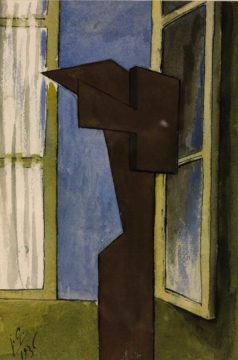Dylan Byron in Lapham’s Quarterly:
 Forster began writing Maurice in 1913, when the British Empire governed nearly a quarter of the earth’s population and the question of nostalgia was beside the point. Forster was thirty-four, eighteen years had passed since Oscar Wilde’s conviction for “gross indecency,” and it would be another fifty-four years before “homosexual acts” were decriminalized in the United Kingdom. Completed in 1914 and subsequently revised several times, Maurice was published only after Forster’s death in 1970, a year after Stonewall; understandably fearing homophobic reprisal, he had refused to publish the novel in his lifetime, instead leaving the manuscript to his friend Christopher Isherwood, who subsequently oversaw its publication in 1971. The barely canonical novel circles around the story of Clive Durham and Maurice Hall, Cambridge undergraduates who fall in love reading Plato’s Symposium and listening to Tchaikovsky’s Pathétique Symphony. In a “Terminal Note” appended in 1960, Forster reveals that Maurice “was the direct result of a visit to Edward Carpenter,” the Cambridge-educated, sandal-wearing gardener, poet, and utopian socialist who lived with his much younger, rather more working-class boyfriend, George Merrill, in Millthorpe, a village in Derbyshire. Forster praises the intellectual example of Carpenter but credits Merrill’s ambient sensuality with instigating the novel:
Forster began writing Maurice in 1913, when the British Empire governed nearly a quarter of the earth’s population and the question of nostalgia was beside the point. Forster was thirty-four, eighteen years had passed since Oscar Wilde’s conviction for “gross indecency,” and it would be another fifty-four years before “homosexual acts” were decriminalized in the United Kingdom. Completed in 1914 and subsequently revised several times, Maurice was published only after Forster’s death in 1970, a year after Stonewall; understandably fearing homophobic reprisal, he had refused to publish the novel in his lifetime, instead leaving the manuscript to his friend Christopher Isherwood, who subsequently oversaw its publication in 1971. The barely canonical novel circles around the story of Clive Durham and Maurice Hall, Cambridge undergraduates who fall in love reading Plato’s Symposium and listening to Tchaikovsky’s Pathétique Symphony. In a “Terminal Note” appended in 1960, Forster reveals that Maurice “was the direct result of a visit to Edward Carpenter,” the Cambridge-educated, sandal-wearing gardener, poet, and utopian socialist who lived with his much younger, rather more working-class boyfriend, George Merrill, in Millthorpe, a village in Derbyshire. Forster praises the intellectual example of Carpenter but credits Merrill’s ambient sensuality with instigating the novel:
More here.
